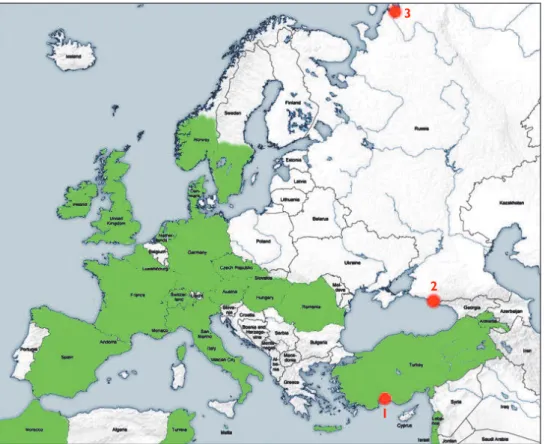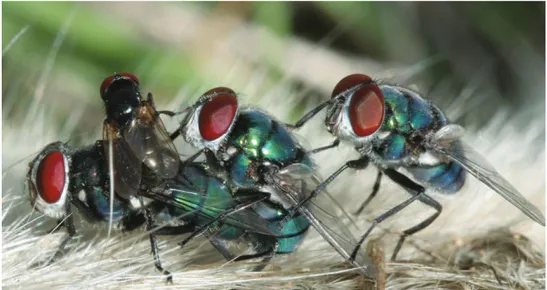New data on the distribution and biology
of the invasive species
Hydrotaea aenescens
(Wiedemann, 1830) (Diptera, Muscidae)
Nikita Vikhrev
Zoological Museum of Moscow State University (ZMMU), Bolshaya Nikitskaya 6, Moscow, Russia
Corresponding author: Nikita Vikhrev (hydrophorus@rambler.ru)
Academic editor: Chris h ompson | Received 17 September 2008 | Accepted 12 December 2008 | Published 17 December 2008
Citation: Vikhrev N (2008) New data on the distribution and biology of the invasive species Hydrotaea aenescens
(Wiedemann, 1830) (Diptera, Muscidae). ZooKeys 4: 47-53. doi: 10.3897/zookeys.4.27
Abstract
Introduced from the New World, H. aenescens has spread rapidly in Europe. h is paper reports new records of H. aenescens from Eastern Europe. Among these records, the one from the far north of European Russia is the most remarkable. New data on the seasonal activity and mating behaviour of H. aenescens are also given. A peak of H. aenescens imago activity in southern Turkey takes place during very early spring. h e mating behaviour of H. aenescens diff ers from that of other members of the genus Hydrotaea.
Keywords
Hydrotaea aenescens, Muscidae, invasive species, introduced species, faunistic records, mating behaviour, courtship, phenology, seasonal activity, Russia, Turkey
Introduction
Hydrotaea aenescens is widely distributed in the Neotropical and Nearctic regions, and was introduced into Europe around 1960 (Saccà 1964). Current data on the dispersal of H. aenescens in Europe is given in Pont et al. (2007).
From my experience, the most attractive substrate for H. aenescens is vertebrate carrion. On the same substrate, I usually found H. aenescens together with another Hydrotaea – our common indigenous H. ignava (Harris). Both fl ies look alike due to their unmodifi ed fore femur and strong metallic shine (previously they were placed in the genus Ophyra), and they have obvious synanthropic trends. When caught, H. aenescens is unmistakable due to its yellow palpi. In the fi eld H. aenescens is slightly www.pensoftonline.net/zookeys
Copyright Nikita Vikhrev. This is an open access article distributed under the terms of the Creative Commons Attribution License, which permits unrestricted use, distribution, and reproduction in any medium, provided the original author and source are credited.
smaller and has a greenish shine instead of the bluish shine in H. ignava. I decided that it would be interesting to compare the behaviour, and especially the courtship and mating strategies, of these two species.
Material and methods
To attract H. aenescens, I used vertebrate carcasses (dog, cat) found near roads. h ese animals had been killed in road accidents and were in various stages of decomposi-tion. Usually I had to move the carcass away from the road to a more suitable place where neither the fl ies nor I would be disturbed.
Observations took place in Turkey near Antalya and in Russia near Sochi and near Narjan-Mar (Fig. 1), between September 2007 and July 2008.
h e collected material is stored in the Zoological Museum of Moscow State Uni-versity, Russia.
To understand the mating behaviour, I simply used visual observations, and I recorded what I saw using photography (CanonD20 digital camera with Canon 100mm/2.8 macro lens).
Results and discussion
I. Distribution and phenology
Records. Turkey, Antalya, near Side, sand dune with pine trees, 02-04 October 2007, cat carcass.
h e only female of H. aenescens was collected among 15-20 females of H. ignava. No males recorded.
Turkey, Antalya, near Side, sand dune with pine trees, 21-27 February 2008, dog carcass. H. aenescens was numerous, with a male/female ratio 2 : 1. H. ignava was not recorded at all.
Turkey, Antalya, near Side, Lake Titreyen, 21-27 February 2008, another dog carcass, half-buried under sand. H. aenescens was common, with a male/female ratio 2 : 1. H. ignava was not recorded at all.
Turkey, Antalya, near Side, Lake Titreyen, 30-31 March 2008, the same dog car-cass, half-buried under sand. H. aenescens was less common than one month previ-ously, with a male/female ratio about 1 : 1. H. ignava, on the contrary, appeared in great numbers, with more males than females. Males of H. ignava hovered above carrion at a height of 10-50 cm.
Russia, Sochi region, Black Sea beach near Veseloe, 23-25 October 2007, dog carcass. Only females of H. aenescens and H. ignava were collected. H. ignava was 3-4 times more abundant than H. aenescens.
Russia, Nenetsk Nat. Res., 60 km north of Narjan-Mar, 68.15N 53.65E, 9-11 July 2008. Males and females of H. aenescens were found in and around a refuse pit for rotten fi sh waste and kitchen garbage. h is refuse pit was near a fi shing shack used by fi shermen and scientists. h e hut was situated at least 50 km away from the nearest inhabited village.
Phenology. It might be thought that H.aenescens, being originally a Neotropi-cal species, might be a warmth-loving species. On the contrary, however, in South Turkey it is among the very few Diptera that emerge as early as in February. h e high percentage of males and high courtship-mating activity observed in Febru-ary testify to the fact that these were not overwintering fl ies but rather a freshly emerged generation.
When it comes to comparing diff erent fi eld observations, there must always be some doubt as to whether the situations are strictly comparable – an observer may suppose the sites and the substrates to be approximately the same, but the fl ies may not see things in the same way. h e dog carcass discovered near Lake Titreyen was placed so as to rule out such a possibility. Because it was half-buried under the sand, decom-position was defi nitely proceeding more slowly than usual and the carcass remained attractive to carrion visitors for a long time. Observations of this carcass showed that H. aenescens appeared one month earlier than H. ignava. We could also observe that in hot periods H. aenescens became much less common than H. ignava.
h e larvae of H. aenescens are often regarded as potential antagonists of the larvae of Musca domestica Linnaeus(Skidmore 1985). I doubt that such antagonism takes place, at least in Southern Turkey. h e activity of M. domestica occurs chiefl y in the hot season, and H. ignava seems much more suited to be a M. domestica antagonist than H. aenescens.
II. Mating behaviour
Mating behaviourwas observed on the dog carcasses during the period 22-27 February 2008. Males were found sitting on and around carrion, often changing positions but clearly avoiding shaded sites. I would characterize the mating behaviour of H. aenescens as follows: trying to copulate with any fl y of the same size or bigger (preferred), with a metallic shine, in sunlight. Females spent more time in the shade under the carcass, where it was suitable for oviposition, and were not commonly the object of such court-ship, but male-to-male mating attempts were regular and numerous. h is behaviour was diffi cult to record on camera since the male underneath immediately tried to es-cape or to change his position to the upper one. To make an image of an immobile copulating pair attacked by another male was a much easier task.
Calliphoridae of both sexes also attract H. aenescens males. Fig. 3 shows Lucilia sericata (Meigen) (large and shining, as H. aenescens prefers) and Calliphora vomitoria (Linnaeus) (not very shining, but large in size) with H. aenescens males.
Fig. 1. Map showing the records of H. aenescens: 1 – Turkey, Antalya, near Side; 2 – Russia, Sochi region, near Veseloe; 3 – Russia, 60 km North of Narjan-Mar, 68.15N 53.65E. Countries where H.aenescens was previously recorded (Pont et al. 2007) are marked in green.
However, the species that suff ers the most from this sexual harassment is Chrys-omya albiceps (Wiedemann). h is can be described as a case of ‘the biter being bitten himself ’, because, in their turn, males of C. albiceps display the same mating behav-iour with male-to-male attempts and the disturbance of copulating pairs by another male(s). h e next photograph will illustrate this (Fig.4).
Piophilidae, Sarcophagidae and Fanniidae were totally ignored, probably because they were too small or not shining.
A normal copulation of H. aenescens was also observed, although not very often. Copulation was on or around carrion and lasted for 2-6 minutes.
In late March, males of H. ignava exhibited a very spectacular hovering behaviour above carrion.
No hovering/swarming by H. aenescens was observed during my observations. Fur-thermore, I am certain that it never happens because swarming is replaced by the mat-ing behaviour described above. To my knowledge, the non-swarmmat-ing courtship of H. aenescens is unique in the genus Hydrotaea.
Fig. 2. Copulating pair of H. aenescens attacked by another male.
Acknowledgements
I thank Chris Raper and Susan Walter for correcting my English. I especially thank Dr. Adrian C. Pont for reviewing and correcting this paper.
Fig. 4. A copulating pair of C. albiceps attacked by males of H. aenescens and C. albiceps at the same time.
References
Pont A.C., Lole M.J., Leblanc H.N. and Cole J.N. (2007) h e American black dump fl y
Hy-drotaea aenescens (Wiedemann, 1830) (Diptera, Muscidae) in Britain and Ireland. Dipter-ists Digest 14, 23-29.
Rognes K., (1982) Some interesting captures of Muscidae (Dipt.) from Norway. Fauna nor-vegica 29, 40-44.
Saccà G. (1964) Nota sulla presenza in Europa di Ophyra aenescens Wied. (Diptera, Muscidae). Rivista di Parassitologia 25, 295-296.
Skidmore P. (1985) h e biology of the Muscidae of the World. Series entomologica 29,


